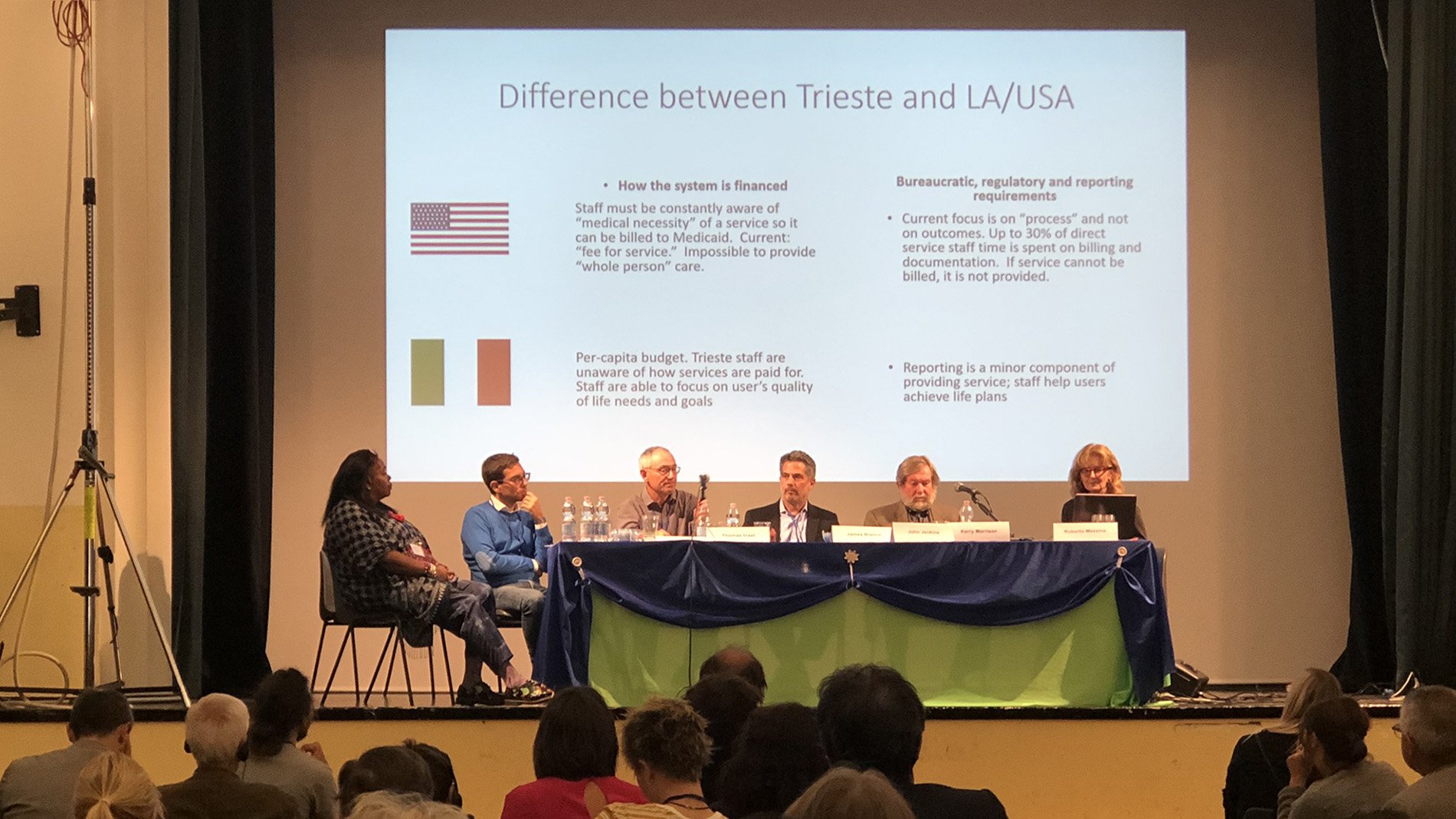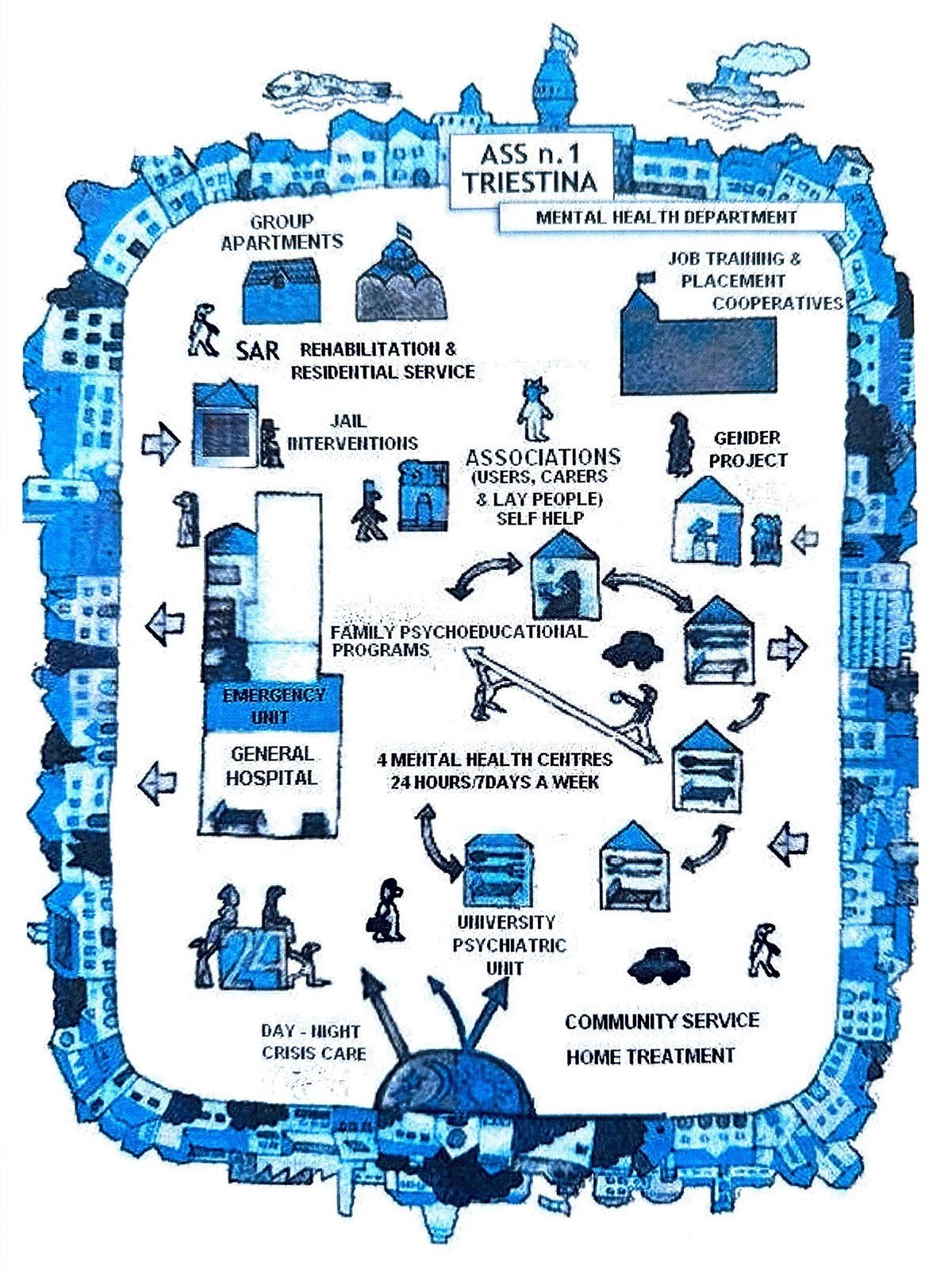Trieste Model
How the Model Works
Trieste is a city of approximately 230,000 people located in the northern part of Italy near the Slovenian border. In this city, the Dipartimento di Salute Mentale has divided the city into four catchment areas. Each area is served by a Community Mental Health Center (CMHC), largely available to the community 24/7 and with a handful of emergency beds. The staff of the CMHC – clinical, nursing and peer specialists – feel a sense of accountability for the people who live within their catchment area.
For example, if someone is hospitalized in the Central Hospital of the city (which has a psychiatric services ward with six beds, in an unlocked setting with no restraints used) a psychiatrist from the CMHC will visit the patient and work to quickly integrate them back into their family, their apartment, their daily life.
Users (this is how they are referred – gli utenti) live integrated throughout the community, either with family, in independent apartments or in congregate living residences, depending upon need. An infrastructure of social support is provided through various clubs and associations and a network of social cooperatives provide opportunities for people to pursue work and participation in economic life.
Because of the nature of public health care in Italy, the regional government provides a budget from which the services are provided. Hence, there is the ability to provide centralized resource delivery and provide for holistic human needs.
As is described in this excellent article by Rob Waters, “The Old Asylum Is Gone: Today a Mental Health System Serves All (For Now)“, “… Basaglia forged a new community-based system from the ashes – and budget – of the 1,200-bed hospital. The funds that had been spent running the sprawling asylum didn’t disappear, as they did when mental hospitals were shuttered in the US. When Trieste’s asylum finally closed in early 1980, Franco Rotelli, Basaglia’s successor as mental health director, was able to use the funds supplied by the regional government to run the new system and develop a new approach to care.”
Guiding Principles of the Trieste Model that Inspire Us
Social Recovery: Human connection is therapeutic and can be more impactful than psychiatric interventions. Kinship – family, friends and pets – matter
Purposeful Life: You have a human right to pursue meaning in life that comes from work, creativity and the opportunity to learn
System Accountability: You will not be left to figure out this system alone. We will catch you if you fall. You will be served by familiar faces who won’t lose you
Whole Person Care: You are not your diagnosis. We will support you in your life plans and your daily needs.

The Secret Sauce
The secret sauce, to boil it down to one approachable concept, is a cultural ethos that embraces accoglienza – or Radical Hospitality. Radical Hospitality assumes a horizontal relationship between two human beings and seeks to check the box on four dimensions:
We see you
We hear you
You are safe here
Your voice matters
To truly do justice to explaining the Trieste model — especially to an American audience — it is best to describe it by what it is not. Some have suggested the dichotomy is as simple as comparing and contrasting a medical or clinical model of care (U.S.) as opposed to a psycho-social model of care which is more holistic and takes into consideration a person’s physical, emotional and mental well-being. That may be a good start, but checking the Radical Hospitality boxes should seal the deal.

How the Trieste System Differs from the US Model
We move away from… |
...toward |
| seeing people as a diagnosis | understanding people’s life stories and life plans |
| hierarchical relationships that elevate clinicians, social workers or staff over clients | horizontal relationships between people; kinship |
| punitive rules or requirements | empowerment through mutually negotiated strategies |
| the sterility of institutional life | the warmth of a home or family ethos |
| prohibition against or avoidance of chores or responsibility | voluntary participation in daily community life |
| social isolation from neighbors, family, friends or community | full participation in community life in all its aspects |
| being “cared for” | caring for others through work, service, purposeful engagement |
The Trieste Model in Los Angeles
Owing to the relationship cultivated between the city of Trieste and Los Angeles County, through several visits and a collaborating agreement, a proposal was submitted to the state’s Mental Health Services Oversight & Accountability Committee (MHSOAC) to propose a five-year pilot inspired by the guiding principles witnessed in Trieste. In May, 2019, the MHSOAC awarded LA County $116M to conduct a five-year pilot.
With the disruption of the pandemic, the planning for the pilot implementation was delayed, and in April 2021, the county presented a proposal to implement a revised scope of work from the original 2019 proposal. With this revision granted by the state, the county proceeded to formulate a pilot that has become known as Hollywood 2.0.
Heart Forward LA is actively involved in participating in the community input process to advise the Department of Mental Health on the roll-out of the ecosystem of community supports associated with the pilot. Hollywood 4WRD is the interlocutor between the community and DMH and Heart Forward is directly involved with this organization.




